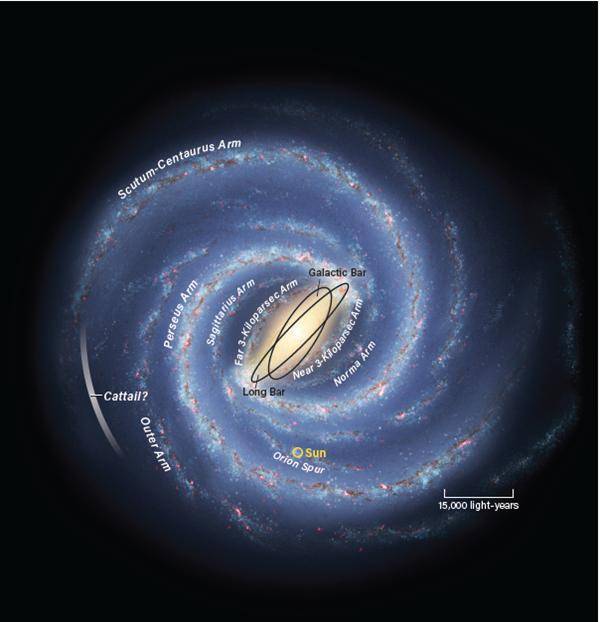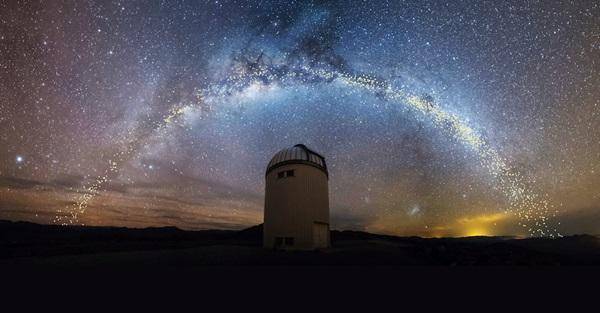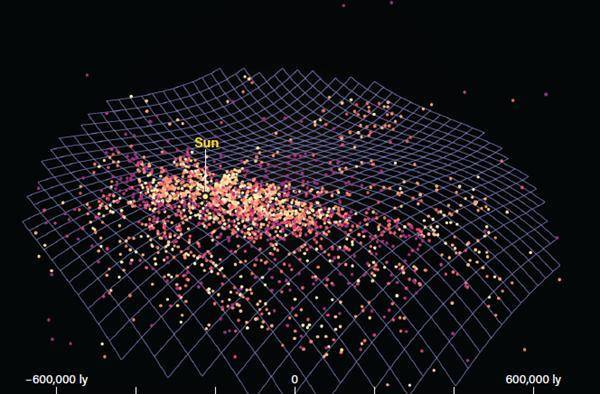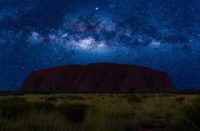This is true in our galaxy and in other galaxies. The only explanation — without changing the laws of gravity — is the existence of unseen greater mass, possibly in the form of dark matter. But this dark matter has never been directly observed.
Standing out under a dome of shining stars and learning about their true nature is an astonishing feat of human intellect. Understanding the vastness of our galaxy and our place in it is an astonishing display of human imagination. Democritus envisioned a multitude of stars that he could not see. Thanks to the countless astronomers who followed him, we have found our true place in the galaxy we call home.

The Milky Way’s luminous belt, from Cassiopeia to Scorpio, stretches over Panamint Valley in Death Valley National Park. Turn your gaze to the night sky and you’ll see a bright, hazy band of light streaking across the sky. For thousands of years, observers have speculated about the true nature of the Milky Way. The Greeks said a haze in the sky was milk spewing from the breast of the goddess Hera, the Egyptians believed it was milk, and some Aboriginal Australians believed it was a river flowing through the sky.
Today, we know that we are looking along the plane of a spiral galaxy composed of at least 100 billion stars. But it wasn’t until the 20th century that people found it necessary to understand the shape of the Milky Way. The problem is that we can’t get a bird’s-eye view of our galaxy because our solar system is buried in the Milky Way. But with the invention of telescopes, photography, spectroscopy and radio astronomy, we have revealed the shape and size of our galaxy — and our place among the billions of stars that make up our island universe.
Telescope Revolution
Before the advent of telescopes, we didn’t have a clear idea of the extent of the Milky Way. About 25 centuries ago, the Greek philosopher Democritus proposed that the Milky Way is full of stars that seem to fuse together because of their great distances. However, 100 years later, Aristotle proposed that the hazy river of light was an atmospheric phenomenon. Aristotle’s authority was accepted for nearly 2,000 years, until two small pieces of glass finally knocked him down.
Galileo observed targets such as the Orion Nebula (M42) and the Beehive Cluster (M44) in the constellation Cancer, discovering countless stars that are invisible to the naked eye. He thought that all the blurry objects in the sky would turn into stars; astronomers didn’t know that everyone would play a role in painting our pictures of the Milky Way.

Helix Nebula
Following his overnight success with the discovery of Uranus in 1781, William Herschel was quickly appointed as an astronomer to the court of King George III. The king gave him money to build telescopes, including his 40-foot-long (12-meter) telescope and a 48-inch mirror.
With it, Herschel produced perhaps the first systematic map of the Milky Way. He first looked at a dense region of the Milky Way and then counted the number of stars in the field of view. When he left the galaxy, the number of stars decreased.
Herschel assumed that the number of stars in each region was a direct indication of the number of stars in that direction. He didn’t know what faintness had to do with distance, or that millions of faint stars were obscured from his view, and he drew a map of the Milky Way that looked like a giant amoeba !
By the 1840s, Herschel’s outfit was dwarfed by the Leviathan in Parsonstown, Ireland. The massive telescope’s 72-inch mirror was built for William Parsons, Earl of Ross, and allowed Ross to make extremely detailed drawings of what he saw. In particular, his observations of the spiral galaxy (M51), the Triangulum galaxy (M33), and M99 (NGC4254) showed different spiral structures. Without a proper way to measure distances, astronomers can only question whether these nebulae, such as stars and star clusters, are within the Milky Way. After all, if they are distant structures beyond the Milky Way, what does that mean for our place in the universe?
cosmic scale
Debates over the physical properties of the Milky Way continued into the early 20th century. Two new technologies helped drive the discussion: spectroscopy and photography. The ability to analyze starlight gives astronomers a powerful new way to understand the chemistry of stars, while photography enhances the limited light-gathering ability of the human eye.
Using these tools, astronomers Henrietta Leavitt, Edward C. Pickering and Ejnar Hertzsprung discovered and defined the relationship between the dimming and brightening cycles of a class of stars called Cepheid variables. In 1908, Levitt was studying variable stars in the Large Magellanic Cloud and Small Magellanic Cloud photographs sent from the Harvard Observatory in Peru to the Harvard College Observatory where she worked. She noticed regular and predictable changes in the brightness of these stars in the Large and Small Magellanic Clouds that could last from a day to more than a month and then repeat.
In addition, she found that the longer the change period, the brighter the star appeared to be. Since all the stars in the Small Magellanic Cloud are roughly the same distance apart, she deduced that the Cepheid’s period is related to its true intrinsic brightness.
Observatory director Pickering believes that this period-luminosity relationship may help determine the distribution of star clusters and nebulae. Hertzsprung was able to calibrate the technique by using the parallax method to make independent distance measurements of Cepheid variables, observing how much they shifted relative to background stars as Earth orbited the sun.
So by measuring a Cepheid’s period, astronomers can know its true brightness — and by comparing it to its apparent brightness, calculate its distance. Astronomers finally have a reliable cosmic scale.
Using this data, Shapley not only located the center of our galaxy — in the constellation Sagittarius — but also showed that the Milky Way is 10 times larger than previously estimated. His observations also moved our solar system away from the galactic center. Given the size of our galaxy, Shapley is convinced that the Helix Nebula, like the globular clusters, are part of the Milky Way.

Cepheids are still important for understanding the shape of the Milky Way. Each point in this image is a Cepheid variable, and its distance was measured by a team using the Optical Gravitational Lensing Experiment (OGLE) telescope at the center of the Las Campania Observatory in Chile.
big debate
By the early 20th century, speculation about the nature of the Helix Nebula and the Milky Way had reached a fever pitch. Photography clearly shows these nebulae have clear spirals of countless stars, but there are no good distance measurements to verify that they are within the Milky Way.
Cepheids finally settled the debate. A few years later, while using the 100-inch Hooker Telescope at Mount Wilson Observatory in California, Edwin Hubble discovered the Cepheid variable in the Andromeda Helix Nebula. Using Shapley’s calibration of Levitt’s period-luminosity relationship, Hubble showed the object was 900,000 light-years away, well beyond the outer reaches of the Milky Way. (This number was later refined to 2.5 million light-years.) In one measurement, he proved that the Milky Way is not the entire universe, but part of a vast cosmic ocean of islands.

The rise of radio astronomy
In the 19th century, astronomers were baffled by large regions along the Milky Way with few stars. These so-called pockets of coal look like black holes against a starry backdrop. At least one astronomer speculates that they may be openings to heaven!
Because exploration of the Milky Way was limited to visible light at the time, astronomers didn’t know that the coal pockets were giant clouds of gas and dust that blocked the light of distant stars. New technologies need to be developed before astronomers can explore and understand these frigid dark clouds that spread across the plane of the Milky Way.
The birth of radio astronomy provided this new tool and led to the discovery that the Milky Way is not only filled with dust, but also with vast amounts of cold neutral hydrogen gas. Most of the time, the protons and electrons of a hydrogen atom spin in the same direction. But sometimes, the electrons flip and spin in the other direction. For any given hydrogen atom, this happens only about once every 100 million years. When it happens, it emits energy with a wavelength of 21 centimeters. These waves travel directly through dust clouds that hide visible light, which has much shorter wavelengths.
When astronomers first detected the 21-centimeter radiation in 1951, they began using it to finally peer into these clouds to construct a more complete picture of our galaxy. By noting the distribution of neutral hydrogen, astronomers can map out invisible parts of the Milky Way, tracing the spiral arms where the hydrogen is concentrated.



GIPHY App Key not set. Please check settings